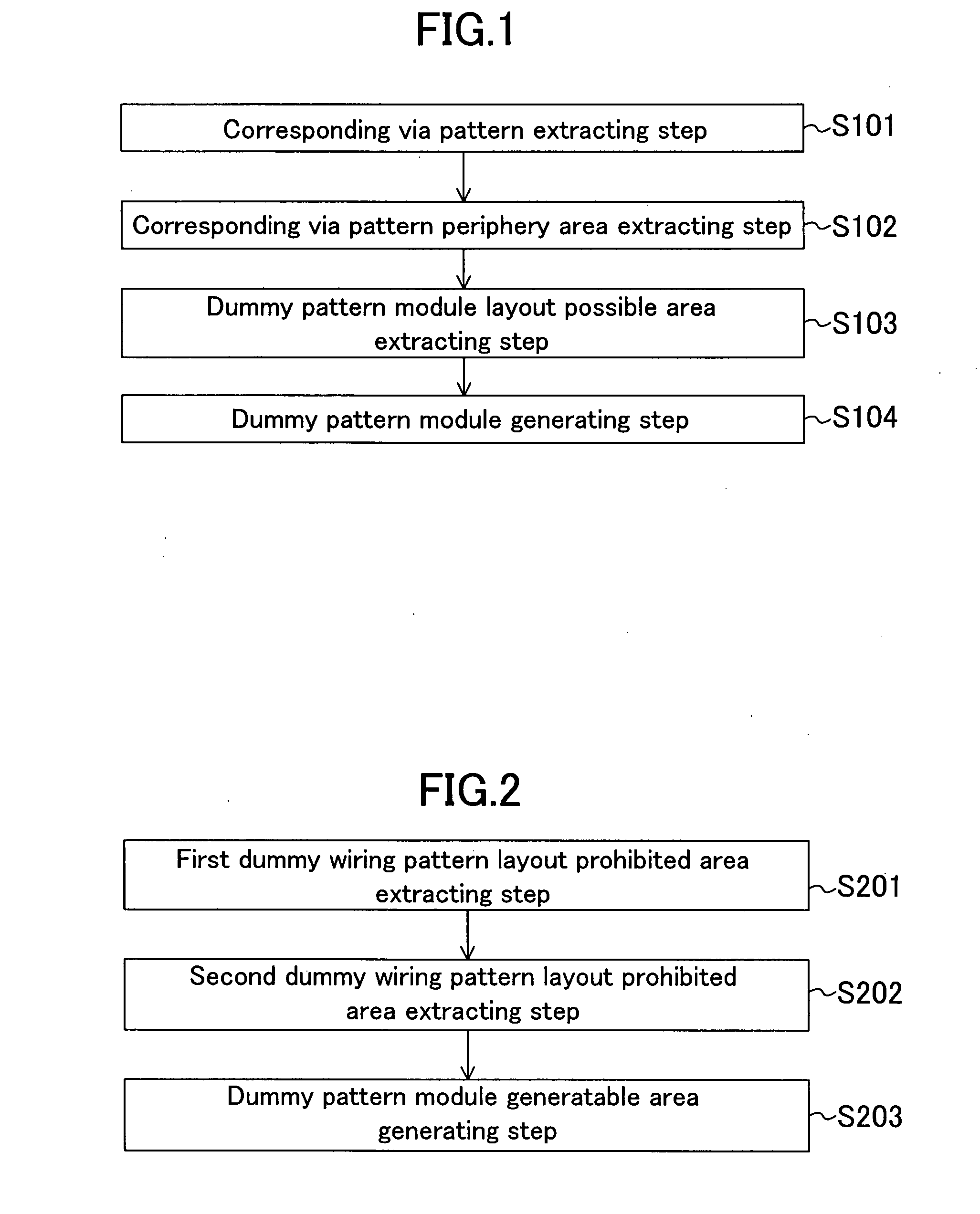Semiconductor device and wiring auxiliary pattern generating method
a technology of auxiliary pattern and semiconductor device, which is applied in the direction of semiconductor device, semiconductor/solid-state device details, electrical apparatus, etc., can solve the problems of inability to dispose of dummy wiring, inability to provide dummy wiring and dummy via, and thin interlayer insulating film, etc., and achieve low probability of generating inconvenience such as under-etching and connection failur
- Summary
- Abstract
- Description
- Claims
- Application Information
AI Technical Summary
Benefits of technology
Problems solved by technology
Method used
Image
Examples
first embodiment
[0051]FIG. 1 is a flowchart for illustrating a wiring auxiliary pattern generating method according to a first embodiment of the present invention, and FIG. 2 is a flowchart for illustrating in detail a part of the steps in the wiring auxiliary pattern generating method according to the first embodiment. Further, FIG. 3A is a plan view for showing a wiring layout when a semiconductor integrated circuit is viewed above, and FIG. 3B is a sectional view of the semiconductor integrated circuit taken along the line IIIb-IIIb of FIG. 3A. FIG. 4A is a plan view for showing a wiring layout when a semiconductor integrated circuit to which the wiring auxiliary pattern generating method according to the first embodiment is applied is viewed from above, and FIG. 4B is a sectional view of the semiconductor integrated circuit taken along the line IVb-IVb of FIG. 4A. FIGS. 5A -5J are diagrams for describing the procedure for applying the wiring auxiliary pattern generating method according to the ...
second embodiment
[0076]FIG. 7 is a flowchart for illustrating the dummy pattern module generating method according to a second embodiment of the present invention. FIG. 8 is a flowchart for illustrating in detail the steps shown in FIG. 7 in the wiring auxiliary pattern generating method according to the second embodiment. FIGS. 9A and 9B are plan views for describing the wiring auxiliary pattern generating method of this embodiment, which illustrate examples of the actual pattern. FIG. 5 is used for describing the wiring auxiliary pattern generating method of this embodiment.
[0077] The wiring auxiliary pattern of this embodiment is generated in the following manner.
[0078] First, as shown in FIG. 7, the steps s101-s104 are carried out. In the step s104, the dummy pattern modules 19a-19k shown in FIG. 5J are outputted.
[0079] Then, among the dummy pattern modules generated in the step s104, dummy pattern modules connected to a part of the wiring patterns are eliminated in a step s301. Specifically,...
third embodiment
[0087]FIG. 10 is a flowchart for illustrating the wiring auxiliary pattern generating method according to a third embodiment of the present invention. FIGS. 11A and 11B are plan views for describing the wiring auxiliary pattern generating method according to the third embodiment, which respectively illustrate actual pattern examples. FIG. 5, which is referred to in describing the first embodiment, is used for describing the wiring auxiliary pattern generating method of this embodiment.
[0088] The wiring auxiliary pattern of this embodiment is generated in the following manner.
[0089] First, the steps s101-s104 and the step s301 shown in FIG. 10 are carried out. The steps s101-s104 are the same steps as those described in the first embodiment, and the step s301 is the same step as that described in the second embodiment. That is, the dummy pattern modules 19a-19k shown in FIG. 5J are outputted in the step s104, and dummy pattern modules 19d, 19e among the dummy pattern modules 19a-19...
PUM
 Login to View More
Login to View More Abstract
Description
Claims
Application Information
 Login to View More
Login to View More - R&D
- Intellectual Property
- Life Sciences
- Materials
- Tech Scout
- Unparalleled Data Quality
- Higher Quality Content
- 60% Fewer Hallucinations
Browse by: Latest US Patents, China's latest patents, Technical Efficacy Thesaurus, Application Domain, Technology Topic, Popular Technical Reports.
© 2025 PatSnap. All rights reserved.Legal|Privacy policy|Modern Slavery Act Transparency Statement|Sitemap|About US| Contact US: help@patsnap.com



